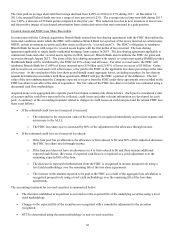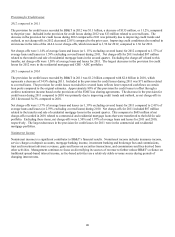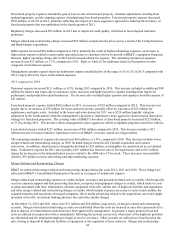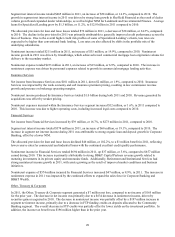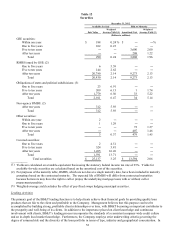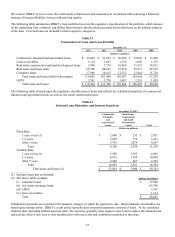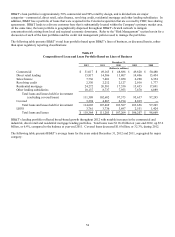BB&T 2012 Annual Report Download - page 66
Download and view the complete annual report
Please find page 66 of the 2012 BB&T annual report below. You can navigate through the pages in the report by either clicking on the pages listed below, or by using the keyword search tool below to find specific information within the annual report.
44
Foreclosed property expenses include the gain or loss on sale of foreclosed property, valuation adjustments resulting from
updated appraisals, and the ongoing expense of maintaining foreclosed properties. Foreclosed property expense decreased
$536 million, or 66.8% in 2012, primarily reflecting the impact of a more aggressive approach to reducing the inventory of
foreclosed property that was undertaken in the fourth quarter of 2011.
Regulatory charges decreased $53 million in 2012 due to improved credit quality, which led to lower deposit insurance
premiums.
Merger-related and restructuring charges increased $52 million compared to the prior year as a result of the Crump Insurance
and BankAtlantic acquisitions.
Other expense increased $62 million compared to 2011, primarily the result of higher advertising expenses, an increase in
depreciation expense related to assets under operating leases to customers driven by growth in BB&T’ s equipment financing
business, higher operating charge-offs in 2012 and increased referral fee expense. The remaining noninterest expenses
increased a net $13 million, or 3.3%, compared to 2011. Refer to Table 10 for additional detail on fluctuations in other
categories of noninterest expense.
Management currently expects that total noninterest expense should decline in the range of 1% to 2% in 2013 compared with
2012, largely driven by lower credit-related expenses.
2011 compared to 2010
Personnel expense increased $111 million, or 4.2%, during 2011 compared to 2010. This increase included an additional $90
million for salaries and wages due to customary salary increases and higher incentive expense resulting from improved
performance and production-related businesses. The increase also included higher pension and employee benefits expense of
$21 million.
Foreclosed property expense totaled $802 million in 2011, an increase of $55 million compared to 2010. This increase was
largely due to an increase of $78 million for losses and write-downs, partially offset by a decrease of $23 million for
maintenance and repair costs. Included in the losses and write-downs for 2011 was a $220 million liquidity valuation
adjustment in the fourth quarter related to management’ s decision to implement a more aggressive shorter period disposition
strategy for foreclosed properties. The carrying value of BB&T’ s inventory of foreclosed property decreased $723 million,
or 57.4%, during 2011. This decline reflects management’ s more aggressive efforts to liquidate properties and fewer inflows.
Loan-related expense totaled $227 million, an increase of $26 million compared to 2010. This increase includes a $12
million increase for losses related to repurchase reserves on BB&T’ s investor owned servicing portfolio.
The remaining noninterest expenses decreased a net $60 million, or 2.8%, compared to 2010. This decrease includes lower
merger-related and restructuring charges, as 2010 included charges related to the Colonial acquisition and systems
conversion. In addition, amortization of intangibles declined by $23 million, as intangibles are amortized on an accelerated
basis. Noninterest expense for 2011 also includes a $16 million loss from the sale of leveraged leases and an $11 million
charge for an increase to the indemnification reserve related to the 2008 sale of Visa stock. These increases were partially
offset by $19 million in lower advertising and other marketing expenses.
Merger-Related and Restructuring Charges
BB&T recorded certain merger-related and restructuring charges during the years 2012, 2011 and 2010. These charges are
reflected in BB&T’ s Consolidated Statements of Income as a category of noninterest expense.
Merger-related and restructuring expenses or credits include: severance and personnel-related costs or credits, which typically
occur in corporate support and data processing functions; occupancy and equipment charges or credits, which relate to costs
or gains associated with lease terminations, obsolete equipment write-offs, and the sale of duplicate facilities and equipment;
and other merger-related and restructuring charges or credits, which include expenses necessary to convert and combine the
acquired branches and operations of merged companies, direct media advertising related to the acquisitions, asset and supply
inventory write-offs, investment banking advisory fees and other similar charges.
At December 31, 2012 and 2011, there were $11 million and $20 million, respectively, of merger-related and restructuring
accruals. Merger-related and restructuring accruals are established when the costs are incurred or once all requirements for a
plan to dispose of certain business functions have been approved by management. In general, a major portion of accrued
costs are utilized in conjunction with or immediately following the systems conversion, when most of the duplicate positions
are eliminated and the terminated employees begin to receive severance. Other accruals are utilized over time based on the
sale, closing or disposal of duplicate facilities or equipment or the expiration of lease contracts. Merger and restructuring




